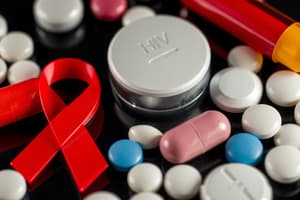Podcast
Questions and Answers
What is the formula to calculate relative risk?
What is the formula to calculate relative risk?
- (a/a+b) / (c/c+d)
- Incidence in non exposed / Incidence in exposed
- Risk in exposed group / Risk in non-exposed group
- Incidence in exposed / Incidence in non exposed (correct)
In the context of relative risk, what does a value of 1 indicate?
In the context of relative risk, what does a value of 1 indicate?
- There is a positive association
- There is no association between risk in exposed and non-exposed (correct)
- Risk in exposed is greater than risk in non-exposed
- Risk in exposed is less than risk in non-exposed
How is risk interpreted when relative risk (RR) is above 1?
How is risk interpreted when relative risk (RR) is above 1?
- Risk is decreased by (1-RR)X100%
- Risk is halved
- Risk remains the same
- Risk is increased by (RR - 1)X100% (correct)
Why can't relative risk be calculated in a case-control study?
Why can't relative risk be calculated in a case-control study?
What does a relative risk value less than 1 indicate?
What does a relative risk value less than 1 indicate?
If incidence among smokers was given as 84 per 3,000 instead of 28 per 1,000, what would be the relative risk?
If incidence among smokers was given as 84 per 3,000 instead of 28 per 1,000, what would be the relative risk?
What is the formula to calculate Incidence Rate?
What is the formula to calculate Incidence Rate?
What does Incidence measure?
What does Incidence measure?
How much did the proportion of the population with HIV change from 2020 to 2021?
How much did the proportion of the population with HIV change from 2020 to 2021?
What is used to determine whether a certain disease is associated with a certain exposure?
What is used to determine whether a certain disease is associated with a certain exposure?
How is Relative Risk defined?
How is Relative Risk defined?
What does Prevalence measure?
What does Prevalence measure?
In a case-control study, the odds ratio is a good estimate of the relative risk when:
In a case-control study, the odds ratio is a good estimate of the relative risk when:
What does an odds ratio of 1 indicate in relation to exposure and disease?
What does an odds ratio of 1 indicate in relation to exposure and disease?
How is the odds ratio calculated in a case-control study?
How is the odds ratio calculated in a case-control study?
When can the odds ratio also be used in cohort studies to estimate the relative risk?
When can the odds ratio also be used in cohort studies to estimate the relative risk?
How is risk affected when the odds ratio is greater than 1?
How is risk affected when the odds ratio is greater than 1?
In which hybrid study design is a case-control study conducted based on a defined cohort?
In which hybrid study design is a case-control study conducted based on a defined cohort?
What was the relative risk for developing breast cancer among women exposed to DDT compared to those not exposed?
What was the relative risk for developing breast cancer among women exposed to DDT compared to those not exposed?
What was the percentage of women who developed breast cancer in the entire cohort?
What was the percentage of women who developed breast cancer in the entire cohort?
Why were all 89,949 baseline blood samples not analyzed?
Why were all 89,949 baseline blood samples not analyzed?
What would be the cost to analyze all 89,949 blood samples if it cost $20 per sample?
What would be the cost to analyze all 89,949 blood samples if it cost $20 per sample?
Which study design could be applied to overcome the cost issue of analyzing all blood samples in this scenario?
Which study design could be applied to overcome the cost issue of analyzing all blood samples in this scenario?
What was the risk ratio among women who developed breast cancer based on DDT exposure status?
What was the risk ratio among women who developed breast cancer based on DDT exposure status?
In a case-control study, what is the purpose of analyzing blood samples from non-diseased women?
In a case-control study, what is the purpose of analyzing blood samples from non-diseased women?
If the odds ratio (OR) for breast cancer in DDT-exposed women is 1.89, what can be inferred about the association between DDT exposure and breast cancer?
If the odds ratio (OR) for breast cancer in DDT-exposed women is 1.89, what can be inferred about the association between DDT exposure and breast cancer?
In a cross-sectional study, what measure is used to determine the association between exposure and disease?
In a cross-sectional study, what measure is used to determine the association between exposure and disease?
If the prevalence ratio is less than 1.0, what does it indicate about the association between exposure and disease?
If the prevalence ratio is less than 1.0, what does it indicate about the association between exposure and disease?
In the given data, what is the total cost of analyzing blood samples for the case-control study?
In the given data, what is the total cost of analyzing blood samples for the case-control study?
Based on the given data, what is the prevalence of breast cancer among the non-exposed women?
Based on the given data, what is the prevalence of breast cancer among the non-exposed women?





